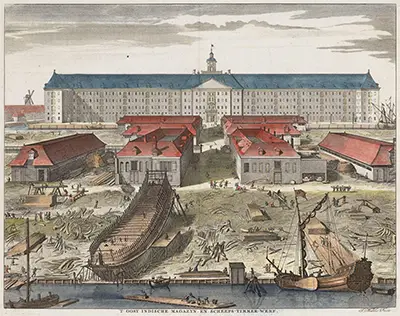The Dutch Republic
Part 2: The Coming of War At the same time, the Low Countries were a haven for Protestant thought and activity. John Calvin, primarily, but also other leaders of the movement against or away from Catholicism found safe havens in the Low Countries, particularly the northern provinces. Charles tried to suppress Protestant activity and even thought in the Low Countries by reinstating the Inquisition; it didn't last long. Charles V abdicated his thrones in 1556. Taking over as King of Spain was his son and heir, Philip II. Eventually named as Holy Roman Emperor was Ferdinand I, Charles's younger brother. 
Philip II carried on his father's proposals of taxation and suppression of Protestantism but with a heavier hand. Further, to protect against subsequent incursions from France, Philip ordered troops to remain in the Low Countries. Residents there who already felt themselves overtaxed now had to pay for this "protection force" as well, in both money and exasperation. Resentment grew. Charles had been born in the Low Countries and had identified with the feelings of the people there, to an extent. Philip, born in Spain, had none of those sympathies and displayed little empathy toward the people's concerns. In protest, some nobles resigned from the Council of State. Among those were three very prominent men: Lamoral, Philip de Montmorency, and William the Silent, more well-known as the first William of Orange. One way in which the residents of the Low Countries expressed their displeasure with such measures of repression as the return of the Inquisition was to practice iconoclasm, the damaging or destruction of monasteries and their contents, such as statues and other art works depicting Catholic religious figures. This violent form of expressing anti-Catholic sentiment had proponents in other Protestant areas as well. The 10 southernmost provinces were generally controlled by Spanish Catholics. The seven provinces in the north (Friesland, Gelderland, Gronigen, Holland, Overijssel, Utrecht, and Zeeland) were the hotbed of Protestant resistance. Philip sent the dedicated Duke of Alba, at the head of 10,000 soldiers, to enact measures of repression in the Low Countries. Among his measures was to bypass Margaret of Parma, half-sister to King Philip II and the intended governor, and act as his own ruler, ordering reprisals and executions, including of powerful nobles, of anyone who opposed Philip and Catholicism. Among those executed were Lamoral and Montmorency. 
William of Orange (right) was one of those who organized the resistance. He and many others had signed petitions to Margaret and Philip, imploring them to find peaceful resolutions to the disputes; their pleas went unheard. As stadtholder of Holland, Utrecht, and Zeeland, William had a powerful position and powerful friends. He also had allies elsewhere. Historians generally regard the issuing of these petitions and the banding together of the Protestant provinces as the birth of the Dutch Republic. The seven northern provinces then joined together in the Union of Utrecht, which was a confederation of states, not a collection of political entities with a strong central authority. The Duke of Alba and his large army were the imperial spearhead of an overall strategy to bring what the emperor viewed as rebellious provinces back into the fold; the "revolutionaries" had other ideas. The result was the Eighty Years War. Imperial forces had the upper hand initially, as the Dutch Republic struggled to find adequate soldier strength and funding. William of Orange sought out alliances elsewhere in Europe, without success. But the Dutch held on and gradually began to turn the tide. A supporter of Philip II assassinated William of Orange in 1584; the States General appointed Maurice of Orange (William's son) to be their leader, and he carried on the campaign with gusto. As the 16th Century wound down and the fighting continued, the Dutch army more and more resembled the kind of hard fighters that Parma had brought with him from the beginning of the war. In just two decades, the Dutch army tripled in size. Dutch forces even took the offensive, in the 1590s taking the siege to several Spanish-controlled centers, including the well defended Coevorden. 
At the same time, Spanish forces fought for supremacy elsewhere. In 1588, however, Philip II turned his anger fully on England. The grand Spanish Armada aimed to turn its full firepower on English ships and shores but ended up retreating in failure. Spain had also become embroiled in the French Wars of Religion; and in 1579, Philip had endeavored to prevent Henry of Navarre from taking over the French throne. Philip found himself again thwarted, as Henry became King Henry IV and then dealt Spanish forces a series of blows, in Burgundy and at Amiens. The Peace of Vervins, in 1598, ended the fighting between France and Spain. Next page > The Golden Age and Modernism > Page 1, 2, 3 |
|
Social Studies for Kids
copyright 2002–2024
David White




